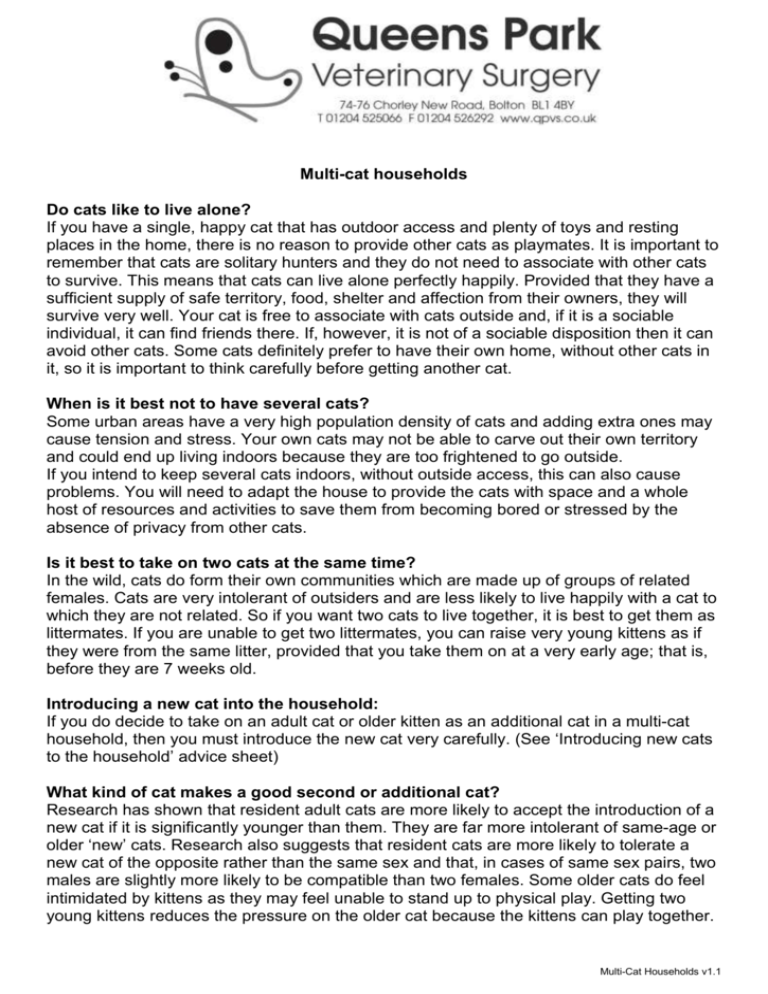Multi-Cat Households v1.1
advertisement

Multi-cat households Do cats like to live alone? If you have a single, happy cat that has outdoor access and plenty of toys and resting places in the home, there is no reason to provide other cats as playmates. It is important to remember that cats are solitary hunters and they do not need to associate with other cats to survive. This means that cats can live alone perfectly happily. Provided that they have a sufficient supply of safe territory, food, shelter and affection from their owners, they will survive very well. Your cat is free to associate with cats outside and, if it is a sociable individual, it can find friends there. If, however, it is not of a sociable disposition then it can avoid other cats. Some cats definitely prefer to have their own home, without other cats in it, so it is important to think carefully before getting another cat. When is it best not to have several cats? Some urban areas have a very high population density of cats and adding extra ones may cause tension and stress. Your own cats may not be able to carve out their own territory and could end up living indoors because they are too frightened to go outside. If you intend to keep several cats indoors, without outside access, this can also cause problems. You will need to adapt the house to provide the cats with space and a whole host of resources and activities to save them from becoming bored or stressed by the absence of privacy from other cats. Is it best to take on two cats at the same time? In the wild, cats do form their own communities which are made up of groups of related females. Cats are very intolerant of outsiders and are less likely to live happily with a cat to which they are not related. So if you want two cats to live together, it is best to get them as littermates. If you are unable to get two littermates, you can raise very young kittens as if they were from the same litter, provided that you take them on at a very early age; that is, before they are 7 weeks old. Introducing a new cat into the household: If you do decide to take on an adult cat or older kitten as an additional cat in a multi-cat household, then you must introduce the new cat very carefully. (See ‘Introducing new cats to the household’ advice sheet) What kind of cat makes a good second or additional cat? Research has shown that resident adult cats are more likely to accept the introduction of a new cat if it is significantly younger than them. They are far more intolerant of same-age or older ‘new’ cats. Research also suggests that resident cats are more likely to tolerate a new cat of the opposite rather than the same sex and that, in cases of same sex pairs, two males are slightly more likely to be compatible than two females. Some older cats do feel intimidated by kittens as they may feel unable to stand up to physical play. Getting two young kittens reduces the pressure on the older cat because the kittens can play together. Multi-Cat Households v1.1 Replacing a housemate after an accident or illness: Friendships between cats are unique and individual and they cannot be replaced by bringing in a new cat. If a pair of littermates has been raised together, their bond is particularly unlikely to be replaced. The remaining cat may experience genuine grief and may search for and call out to the missing sibling. Grieving can go on for a period of several months and is not a good time to introduce another cat. Hostility to a new cat may be very intense. If a new cat is introduced after grieving is over, then the bond is unlikely ever to be as strong as between the previous pair. Successful integration of new cats: Apart from introducing the new cat correctly, it is important to make sure that the cats have enough key resources so that they feel comfortable to co exist without competition. The provision of feeding sites for one or two cats will not be enough when a third or fourth is introduced, as each cat needs its own share of feeding, resting, drinking and litter tray sites. Much like people, cats get along best when they have their own privacy and the amount of indoor space available may not satisfy this need. Greater access to height, with cat furniture, shelves and places to climb, will allow the cats a greater amount of usable space, even though the floor area of the house is unchanged. Taken from ‘Behaviour Problems in Small Animals’ by Jon Bowen and Sarah Heath Multi-Cat Households v1.1





